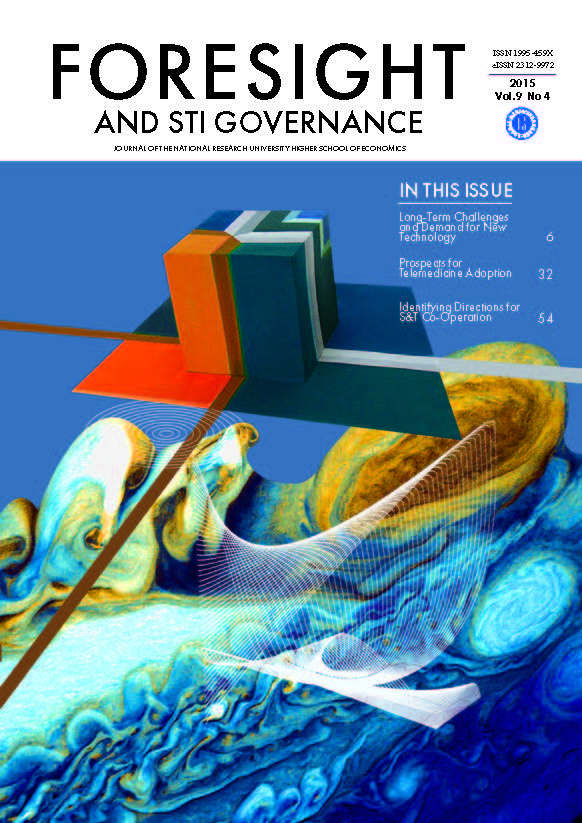Abstract
The issue of forecasting demand for liquid fuels has become particularly significant in recent years with technological development and much tougher inter-fuel competition in the transport sector. In future, these developments could radically transform the oil, gas, and electricity markets. Therefore there is a greater need for improved forecasting methods that take into account the dynamics of market factors, primarily those related to the use of new technologies.
We analyse the difficulties of forecasting demand for liquid fuels in conditions of uncertainty related to future technological developments in car transport. We classify the technologies driving demand for motor fuels by the nature of their impact on the demand for petroleum products: technologies aimed at improving the energy efficiency of traditional cars, as well as drivers of inter-fuel competition, both in terms of direct and indirect substitutes for petroleum products. To resolve the problem of limited input information, the methodology incorporates clustering instruments, which enable us to group countries according to certain criteria. The use of economic and mathematical tools with optimizing units enables us to make integrated calculations that model the market for liquid fuels and assess its interactions with the markets of other energy resources.
Our proposed system for forecasting demand for liquid fuels, including petroleum products, can be used as an instrument to assess the future impact of technological innovation on the development of the oil industry when carrying out Foresight studies.
References
APS (2008) Energy Future: Think Efficiency. College Park, MD: American Physical Society.
Behrang M.A., Assareh E., Ghalambaz M., Assari M.R., Noghrehabadi A.R. (2011) Forecasting future oil demand in Iran using GSA (Gravitational Search Algorithm)//Energy. Vol. 36. P. 5649-5654.
Bhattacharyya S.C., Timilsina G.R. (2009a) Energy Demand Models for Policy Formulation. Policy Research Working Paper. Washington, D.C.: World Bank.
Bhattacharyya S.C., Timilsina G.R. (2009b) Modeling energy demand of developing countries: Are the specific features adequately captured?//Energy Policy. Vol. 38. P. 1979-1990.
Bouachera T., Mazraati M. (2007) Fuel demand and car ownership modeling in India//OPEC Review. Vol. 31. № 1. Р. 27-51.
Button K., Ndoh N., Hine J. (1993) Modeling vehicle ownership and use in low income countries//Journal of Transport Economics and Policy. № 27. Р. 51-67.
Cleveland C.J., Kaufmann R.K., Stern D.I. (2000) Aggregation and the role of energy in the economy//Ecological Economics. Vol. 32. P. 301-317.
Cleveland C.J., O'Connor P. (2010) An Assessment of the Energy Return on Investment (EROI) of Oil Shale. Boston, MA: Boston University.
DOE (2014a) Energy Information Administration International Energy Outlook. Washington, D.C.: U.S. Department of Energy.
DOE (2014b) Transportation Demand Module of the National Energy Modeling System: Model Documentation. Washington, D.C.: U.S. Department of Energy.
Forouzanfar M., Doustmohammadi A., Hasanzadeh S., Shakouri H. (2012) Transport energy demand forecast using multi-level genetic programming//Applied Energy. Vol. 91. № 1. Р. 496-503.
Hartigan J.A., Wong M.A. (1979) Algorithm AS 136: A k-means clustering algorithm//Applied Statistics. Vol. 28. № 1. Р. 100-108.
Hook M. (2009) Depletion and Decline Curve Analysis in Crude Oil Production. Uppsala: Uppsala University.
Hubbert M.K. (1962) Energy Resources. Washington, D.C.: National Academy of Sciences, National Research Council.
IEA (2013) Recourses to Reserves Oil, Gas and Coal Technologies for the Energy Markets of the Future. Paris: International Energy Agency.
IEA (2014) World Energy Outlook 2014. Paris: International Energy Agency.
Kong Z., Dong X., Xu B., Li R., Yin Q., Song C. (2015) EROI Analysis for Direct Coal Liquefaction without and with CCS: The Case of the Shenhua DCL Project in China//Energies. № 8. P. 786-807.
Michel B. (2010) Oil Production: A probabilistic model of the Hubbert curve. Paris: Universite Pierre et Marie Curie.
Nakanishi T. (2006) Supply and Demand Analysis on Petroleum Products and Crude Oils for Asia and the World. Tokyo: Institute of Energy Economy.
OECD, IEA (2010) Sustainable Production of Second Generation Biofuels Potential and Perspectives in Major Economies and Developing Countries. Paris: Organization for Economic Co-operation and Development, International Energy Agency.
OECD, IEA (2011) World Energy Model -Methodology and Assumptions. Paris: Organization for Economic Co-operation and Development, International Energy Agency.
OPEC (2014) World Oil Outlook 2014. Vienna: Organization of the Petroleum Exporting Countries.
Raugei M., Fullana-i-Palmer P., Fthenakis V. (2011) The Energy Return on Energy Investment (EROI) of Photovoltaics: Methodology and Comparisons with Fossil Fuel Life Cycles. Upton, NY: Brookhaven National Laboratory.
Telgarsky M., Vattani A (2010) Hartigan's Method: K-means Clustering without Voronoi//JMLR Workshop and Conference Proceedings. Vol. 9. P. 820-827.
Wang M., Huo H., Johnson L., He D. (2006) Projections of Chinese Motor Vehicle Growth, Oil Demand, and CO2 Emissions through 2050//Transportation Research Record: Journal of the Transportation Research Board. № 2038. P. 69-77.
World Energy Council (2011) Energy & Mobility. Background material report. London: World Energy Council.
Бобылев Ю.Н., Приходько С.В., Дробышевский С.М., Тагор С.В. (2006) Факторы формирования цен на нефть. М.: Институт экономики переходного периода.
Брагинский О.Б. (2012) Прогнозирование российского рынка автомобильных видов топлива. М.: Институт народнохозяйственного прогнозирования РАН.
Горячева A.O., Грушевенко Д.А., Грушевенко Е.В. (2013) Оценка влияния потенциальных шоков на мировой нефтяной рынок//Нефть, газ и бизнес. № 5. С. 37-42.
Григорьев Л., Курдин A. (2013) Экономический рост и спрос на энергию//Экономический журнал ВШЭ. № 3. Р. 414-432.
Грушевенко Д.А., Грушевенко Е.В. (2012) Нефть сланцевых плеев -новый вызов энергетическому рынку? M.: ИНЭИ РАН.
Грушевенко Д.А., Грушевенко Е.В. (2015) Применение метода кластерного анализа при группировке стран для прогнозирования спроса на нефтепродукты//Нефть, газ и бизнес. № 2. С. 23-26.
Макаров A.A., Веселов Ф.В., Елисеева O.A., Кулагин В.A., Малахов В.А., Митрова T.A., Филиппов С.П., Плакиткина Л.С. (2011) Модельно-информационный комплекс SCANER. М.: ИНЭИ РАН.
Макаров A.A., Митрова T.A., Григорьев Л.M., Филиппов С.П. (2013) Прогноз развития энергетики мира и России до 2040 года. М.: ИНЭИ РАН, Аналитический центр при Правительстве РФ.
Митрова T., Галкина A. (2013) Межтопливная конкуренция//Экономический журнал ВШЭ. № 3. С. 394-413.

This work is licensed under a Creative Commons Attribution 4.0 International License.

